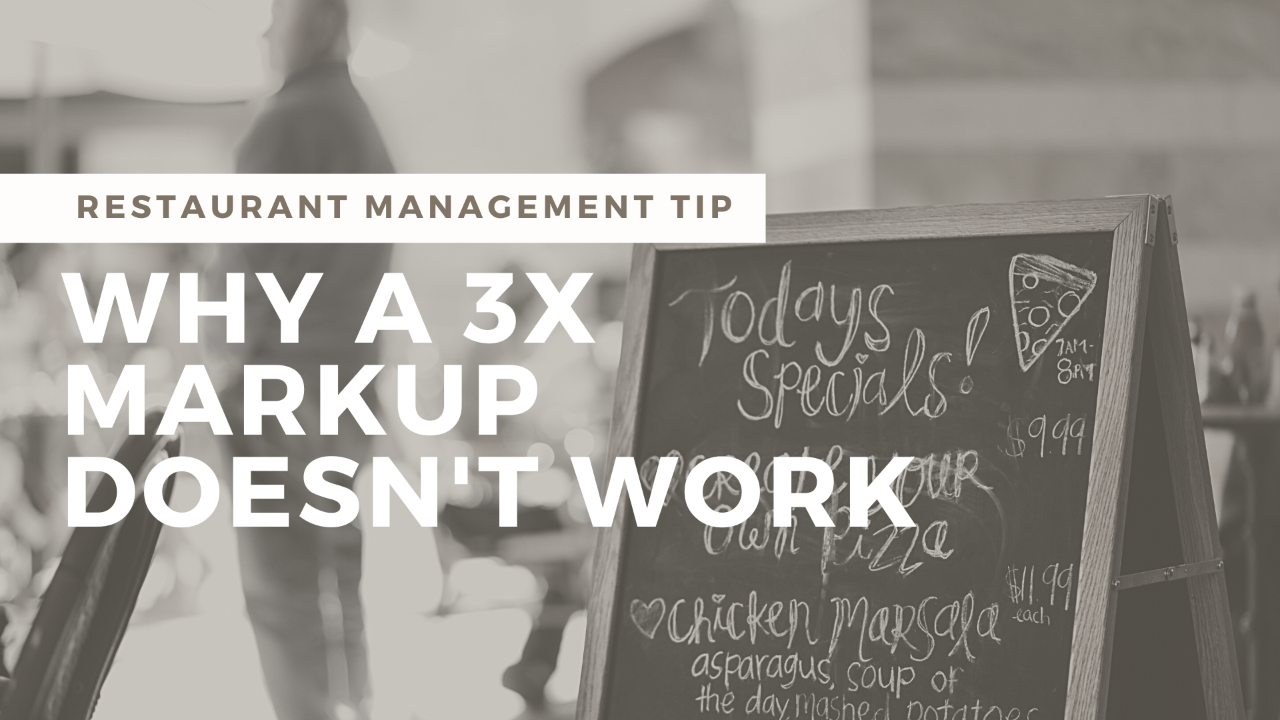Why a 3-Time Markup Doesn't Work for Pricing a Menu

Have you seen the reality TV shows that promote a BS restaurant pricing strategy that has been setting our industry up for failure? Shows like “The Profit” with Marcus Lemonis? I used to like that show a lot, but I also had some problems with it. I watched several episodes where he told restaurant owners they needed to mark their food up three times, and he's not the only expert on TV that's done that. I’ve seen too many restaurant owners follow this outdated profit-killing practice, and I want to explain why a three-time markup doesn’t work for pricing a menu.
The three-time markup is where you take the total cost of the product you put on the plate and then multiply it by three times and that’s how much you charge for that item on your restaurant’s menu. This idea is also based on the advice from organizations such as the National Restaurant Association that your food cost should be around the average of 34%, which is also wrong. There are two problems with this pricing strategy.
- Your restaurant is not average. Are you on the same street corner with the same price point, same style of service, same quality of product, same labor cost, the same set of core values? The answer is no, so an average would include a pizzeria with a seafood restaurant how could they possibly both be shooting for a 34% food cost?
- If you priced everything at a 34 food cost there are items that you'd never be able to sell because they'd be too expensive, and your customers would never buy them. Don’t forget about adding labor cost to that. You might need to shoot for a 24% food cost to make money because labor is so high.
Here are five steps you need to take to price your menu properly and put yourself in a place where you can make money.
- Start with a budget. Budgeting is critical to your success. How will you know where your food cost should be if you don't have a budget? You have to understand a calculation called prime cost, which is total cost of goods sold plus total labor costs including taxes, benefits and insurance. Your prime cost target needs to be based on your restaurant. I teach restaurant owners to aim for 55% or lower if you do at least $850,000 a year in sales. How you get there can be very different from another restaurant. You could run a higher cost of good sold and a lower labor cost or vice versa or dead on the same. But without a budget, without seeing your numbers, you don't know where you need to be so setting your food cost target.
- Use accurate, up-to-date recipe costing cards. This is critical. I often tell people the two most important systems any restaurant should have are budgets and recipe costing cards. You'll never guess what the two systems are most restaurants never have… a budget and recipe costing cards. Why? The excuse I get all the time is they because they're too hard. Are you freaking kidding me? You're in the toughest business I know and as the leader of your business you must know this data. You must have a plan for success. You must know what you're selling and what it costs you in order to charge properly for it. If you're looking for recipe costing card software to handle much more ordering and inventory and even bill pay, visit marginedge.com/DSP. I don’t get a kickback, but if you visit that link you're going to get my guy Bruce, and he is a real restaurant pro.
- Calculate your ideal food cost. Using your product mix – what your customers actually purchased – combined with your recipe costing cards, you can find your ideal food cost, which is what your food cost should be if there was no waste, no theft, no spoilage, if you ran a perfect restaurant, which does not exist. Put that into a spreadsheet I've created called Menu Profitability Monitor and it gives you your ideal cost.
- Decide where you’re going to price your menu in the marketplace. Are you going to undercut your competition and be the dive bar, which I do not recommend, or are you going to price like every one of your competitors? Or are your service and product that much better than the competition so you can charge more?
- Re-engineer your menu. Sort the data in your Menu Profitability Monitor in descending order from the items you sell the most of to the least and then you can decide if you’re going raise the price on your top one to three items in each one of the menu’s sections, if you’re going to drop losers, or add new items. You can look at ways to decrease costs such as buying smarter or decreasing portion sizes. You can new items to the menu and move your mix around to influence your customers’ choices. Scientifically re-engineering a menu can get you to the food cost target you need.
To price your menu profitably, you must have a budget and accurate, up-to-date recipe costing cards. This is why you'll hear me say the two most important systems any restaurant should have are budgets and recipe costing cards.
Be sure to visit my YouTube channel for more helpful restaurant management video tips.




